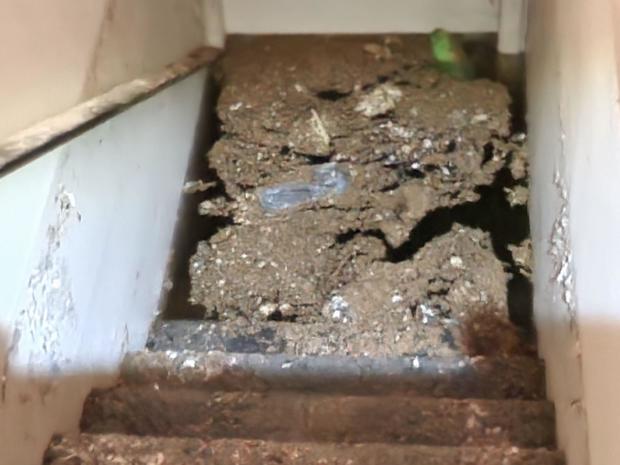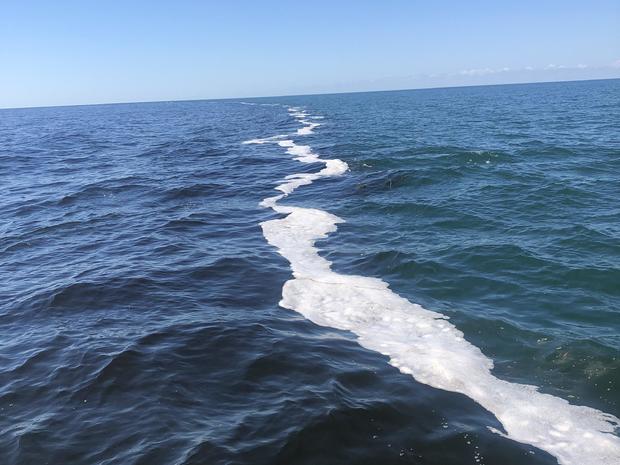Florida water "looks like root beer, smells like dead fish rolled into compost" as environment reels from Hurricane Ian
While Hurricane Ian has passed, it has left a damaging mark on Florida's environment — complete with green sludge, thousands of gallons of leaked diesel and water that "looks like root beer, smells like dead fish rolled into compost."
Records and personal accounts show that Ian's toll is filled with spills and stinky seepages that could spell trouble for the environment. CBS News found at least 20 records of environmentally hazardous issues suspected to be caused by the hurricane that have been reported to the Coast Guard's National Response Center. All of these reports were recorded between September 28, the day Hurricane Ian made landfall, and October 2.
All of the reports in their database are initial calls that have not necessarily been validated or investigated by the appropriate agencies, but nonetheless, they provide a preliminary look at what could be significant tolls from Hurricane Ian. CBS News has asked the National Response Center for more information about the hurricane-related cases.
Among the reports are several instances of sunken vessels, leaking diesel, the release of 2,300 gallons of sodium hypochlorite (bleach) from a pipeline, and in one case, an "unknown green sludge" at an apartment complex in Bonita Springs that a resident claims was causing respiratory issues.
Jaime Ziadie is one of several residents who said he has reported the sludge to federal and state agencies. He told CBS News that his home got an estimated 7 feet of floodwaters in the basement, going up to nearly the second floor — just four staircase steps away from his living room.
"When the water came up, there was a lot of junk in it, like sludge and stuff," he said, adding that it had a "mildewy" odor.
Stanley Rupinski, 70, the president of the complex's homeowner's association, told CBS News it's a "God-awful" situation, with the neighboring canal "severely polluted with dead animals, oil debris and noxious odors." The lower level of the complex has been destroyed, he said, and at least one person in the building has left because she claimed she was having breathing problems from the flooding and debris, an issue Rupinksi said many have complained about.
You don't even have to walk outside to catch the stench, he said — "it's just a nightmare."
He and other residents said they have contacted the county, the EPA and Florida Fish and Wildlife, on top of the National Crisis Center, but Rupinski says they have yet to receive any help. Florida Fish and Wildlife told them that they were focused on search and recovery efforts, he said.
"We've been crippled," he said. "And this is something that's really beyond our control. There's really nothing we can do as people to get this out of here."
Dave Tomasko, executive director of the Sarasota Bay Estuary Program, has seen some of these issues himself. Trucks caught in floodwaters are leaking out battery acid and gasoline, he told CBS News, and there are many flooded properties wrought with pesticides and herbicides that are now getting washed into waterways.
That runoff is so significant that it was captured by NASA satellites. In the images in the tweet below, the colorful turquoise swirls are sediment stirred up in the water, while the brown is runoff from the land.
Tomasko and others have been gathering water samples throughout Florida's west coast – from Boca Grande to Sarasota – that were impacted by Ian. They haven't yet gotten the results, but the environmental impacts of the storm, he said, are quite apparent.
"That stuff that comes out, it just looks like brown sludge coming out," Tomasko told CBS News, saying he saw that runoff when going out to get samples. They were offshore about 1.8 miles when they saw the "plume" coming out.
"In Sarasota Bay, normally this time of year the water is beautiful blue-green, gorgeous," Tomasko said, adding that now, it "looks like root beer, smells like dead fish rolled into compost."
It wasn't turbidity, he said, but tannins — fermented organic material — in roughly the top five feet of the water.
Several waterways have turned into a massive "underwater compost heap" filled with organic material washed in by the storm, Tomasko said. That material is naturally broken down by bacteria, and because of the surplus of materials, it's already causing algal blooms.
In some areas, the water is layering out beneath those blooms, with the bottom layer becoming significantly darker with depleting oxygen levels, he said, adding that this combination can be deadly for marine life.
"You just swim away if you're a big fish, but if you're a small fish, you can't swim far enough to get away from this," he said. "And if you're like something that lives on the bottom of the bay, like an oyster or clam, or a worm or a sea star, it might be that that's going to kill you in place. So, we're probably going to see, I think, a massive amount of fish kill."
Organic material is expected after a major storm, from plants getting destroyed in the wind and rain and excess water. But a lot of the stuff entering the environment isn't natural.
Local environmental group Tampa Bay Waterkeeper conducted their own samples and found that roughly half of their sampling sites "exceeded recreational fecal indicator bacteria limits." Based on their data, they have urged people to avoid getting in the water at six local spots – William's Park, Davis Island Boat Ramp, Rivercrest Park, St. Petersburg Marina, USF Beach and Water Works Park.
Florida Fish and Wildlife Conservation Commission has also found concentrations of Karenia brevis, the organism that causes red tide, in Northwest Florida.
"The thing that freaked me out was, we were going down this street – it's now like a creek – and there's five portapotties...they're all blown over on the side and just there in the water," Tomasko said. "So, cars, trucks, dead animals, alligators, snakes, it's just a mess right now."
There have also been numerous reports of wastewater overflows, he said. In the days following Hurricane Ian, Tomasko said he received 13 notices of overflowing wastewater treatment plants in Manatee and Sarasota Counties alone. He believes those aren't the only overflows — there's a wastewater plant five blocks from his home that's overflowing but hasn't been recorded, he says.
With all of these issues coinciding, Tomasko is concerned that Florida will see something similar to what happened after 2004's Hurricane Charley, when all of Charlotte Harbor had a months-long "oxygen crash."
"We had no oxygen in the river up to 100 miles upstream for about three months," he said. "So, all the fish that lived in that river just basically died and then they got washed down to the harbor."
And after Ian, he said, it "looks really bad."
"And this is worse than Charley," he said. "...We don't really know what this is gonna do. ... We don't know how resilient our systems are gonna be."




